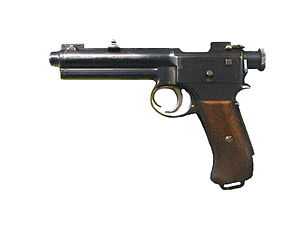Roth-Steyr M1907
| Roth-Steyr M1907 | |
|---|---|
 | |
| Type | Pistol |
| Place of origin |
|
| Service history | |
| In service | 1909-1945 |
| Used by | Austria-Hungary, Austria, Hungary, Italy, Poland, Yugoslavia |
| Wars | World War I, World War II |
| Production history | |
| Designer | Karel Krnka |
| Designed | 1900 |
| Manufacturer | Österreichische Waffenfabriksgesellschaft, in Steyr, and Fegyvergyar, in Budapest |
| Produced | 1908-1914 |
| Number built | 99,000 |
| Specifications | |
| Weight | 34 ounces |
| Length | 23 cm (9.1 inches) |
| Barrel length | 13 cm (5.1 inches) |
|
| |
| Cartridge | 8mm Roth-Steyr |
| Action | self-loading |
| Muzzle velocity | 1090 ft/sec |
| Effective firing range | 75 meters |
| Maximum firing range | 1400 meters |
| Feed system | 10-round integral box magazine |
| Sights | Iron |
The Roth-Steyr M1907, or, more accurately Roth-Krnka M.7[1] was a semi-automatic pistol issued to the Austro-Hungarian Kaiserliche und Koenigliche Armee cavalry during World War I. It was the first adoption of semi-automatic service pistol by the land army of a major power.[2]
Mechanism
The Roth-Steyr pistol fires from an unusual style of locked breech. The bolt is very long. Its rear end is solid, except for a sleeve for the striker, but its front part is hollow and fits tightly over the barrel. The interior of the bolt has cam grooves cut into it, and the barrel has studs which fit into the grooves. When the pistol is fired, the barrel and bolt recoil together within the hollow receiver for about 0.5 inch. During this operation, the grooves in the bolt cause the barrel to turn 90 degrees, after which it is held while the bolt continued to the rear, cocking the action as it does so. For safety with intended use by mounted cavalry, the pistol has a heavy trigger pull against the firing striker spring similar to a hammerless revolver.[3]
The Roth-Steyr is a locked-breech pistol, which allows the barrel and bolt to recoil together within a hollow receiver. It is chambered for a cartridge specific to this model. The Roth-Steyr does not have a detachable magazine, but features a fixed magazine loaded from the top with stripper clips. The sights are fixed, the grips are wooden and terminate in a lanyard ring. Rifling is 4 grooves with right-hand twist.
Production and distribution
The pistol was developed by the Czech designer Karel Krnka, working for an ammunition company of Georg Roth, from an earlier design of Roth-Theodorovic pistol. After development and tests of several prototypes, the final version of the Roth-Krnka won a contest for an Army pistol in 1906, and was adapted as a standard gun of Austro-Hungarian Army as: Repetierpistole M.7. (self-loading pistol M1907).[1] Since Roth had no weapon production capabilities, the government bought all the rights and ordered production in the Österreichische Waffenfabriksgesellschaft (OEWG) in Steyr and FEG in Budapest. From 1908 to 1914, approximately 99,000 weapons were manufactured (the Army received 59,334 from Steyr and 38,213 from FEG, plus several hundreds were sold in civilian market).[1] Despite common name for the pistol Roth-Steyr, Steyr works didn't participate in its design, apart from minor improvements.[1] Following the dissolution of Austria-Hungary, the Roth-Steyr was fielded by Yugoslavia, with limited use during World War II by Austrians and Hungarians. Italy received a number of pistols as World War I reparations from Austria-Hungary, and these pistols were used by Italian troops during World War II.[3] They were used also in Czechoslovakia and Poland.[1]
See also
References
- ↑ 1.0 1.1 1.2 1.3 1.4 (Polish) Leszek Erenfeicht: Pra-pra-Glock: Repetierpistole M.7, in: Strzał Nr. 1(80)/2010, ISSN 1644-4906, pp36-50.
- ↑ Semi-automatic pistols were adapted earlier only by the Swiss Army - Parabellum, Italian Navy - Mauser C96 and the German Navy - Parabellum. Erenfeicht, L. p. 49
- ↑ 3.0 3.1 Smith, W.H.B. Small Arms of the World (1953) Military Service Publishing Company p.13
Further reading
- (German) Karl R. Pawlas, "Pistole Roth-Steyr, Modell 1907 und ihre Vorläufer", Waffen Revue nr. 2, Sept. 1971, pp. 237-264
External links
| Wikimedia Commons has media related to Roth-Steyr. |
- http://www.google.com/patents/US616260
- http://www.google.com/patents/US616261
- [http://ww2.rediscov.com/spring/VFPCGI.exe?IDCFile=/spring/DETAILS.IDC,SPECIFIC=9692,DATABASE=objects, PISTOL, SEMI-AUTOMATIC - AUSTRIAN PISTOL M07 "ROTH-STEYR" 8MM SN# 13858 - Springfield Armory Museum]